2021 FORD ESCAPE seats
[x] Cancel search: seatsPage 4 of 589

Contacting Us
Contacting Us
..................................................15
Introduction
About This Publication .................................
17
Using This Publication .................................
18
Symbols Glossary
Symbols Used on Your Vehicle .................
19
Data Privacy
Data Privacy .....................................................
22
Service Data ....................................................
23
Event Data ........................................................
23
Settings Data ..................................................
24
Connected Vehicle Data .............................
24
Mobile Device Data .......................................
25
Emergency Call System Data ...................
25
At a Glance
Instrument Panel ..........................................
26
Child Safety
Child Safety Precautions ............................
28
Child Restraint Anchor Points ..................
29
Child Restraints .............................................
30
Installing Child Restraints ...........................
31
Booster Seats .................................................
36
Child Safety Locks ........................................
38
Seatbelts
Seatbelt Precautions ...................................
39
Fastening the Seatbelts .............................
40
Sensitive Locking Mode .............................
40
Automatic Locking Mode ............................
41
Adjusting the Seatbelts During Pregnancy ....................................................
42
Adjusting the Seatbelt Height ..................
42
Seatbelt Reminder ........................................
42Checking the Seatbelts
..............................
44
Seatbelt Extensions .....................................
45
Personal Safety System ™
What Is the Personal Safety System ........................................................................\
..
46
How Does the Personal Safety System Work ..............................................................
46
Personal Safety System Components ........................................................................\
..
46
Airbags
How Do the Front Airbags Work ..............
47
How Do the Side Airbags Work ................
47
How Do the Knee Airbags Work ..............
48
How Does the Safety Canopy ™ Work
........................................................................\
..
48
Airbag Precautions .......................................
49
Properly Adjusting the Driver and Front Passenger Seats .......................................
50
Children and Airbags ...................................
50
Front Passenger Sensing System ............
51
Crash Sensors and Airbag Indicator .......
54
Disposing of Airbags ....................................
55
Pedestrian Alert System
What Is the Pedestrian Alert System ........................................................................\
..
56
911 Assist
What Is 911 Assist ..........................................
57
Emergency Call Requirements .................
57
Emergency Call Limitations .......................
57
Keys and Remote Controls
Remote Control Limitations .....................
58
Using the Remote Control .........................
58
Opening and Closing the Flip Key ...........
58
Removing the Key Blade ............................
59
Sounding the Panic Alarm .........................
59
Locating Your Vehicle ..................................
59
1
Escape (CTC) Canada/United States of America, Vehicles Built From: 02-11-2020, enUSA, Edition date: 202011, First-Printing Table of Contents
Page 8 of 589

Switching the Head Up Display On and
Off ..................................................................131
Head Up Display Settings ..........................
131
Head Up Display Indicators ......................
132
Head Up Display – Troubleshooting ........................................................................\
.
133
Remote Start
What Is Remote Start ................................
134
Remote Start Precautions .......................
134
Remote Start Limitations .........................
134
Enabling Remote Start ..............................
134
Remotely Starting and Stopping the Vehicle .........................................................
134
Extending the Remote Start Duration ........................................................................\
.
134
Remote Start Remote Control Indicators ........................................................................\
.
135
Remote Start Settings ...............................
135
Climate Control
Manual Climate Control ............................
137
Automatic Climate Control - Vehicles With: Dual Automatic Temperature
Control (DATC) ........................................
138
Automatic Climate Control - Vehicles With: Electronic Automatic
Temperature Control (EATC) ...............
141
Hints on Controlling the Interior Climate - Vehicles With: Automatic
Temperature Control .............................
144
Hints on Controlling the Interior Climate - Vehicles With: Manual Temperature
Control .........................................................
145
Heated Windshield .....................................
146
Heated Rear Window .................................
146
Heated Exterior Mirrors .............................
146
Interior Air Quality
What Is the Cabin Air Filter .......................
147
Replacing the Cabin Air Filter ..................
147Front Seats
Front Seat Precautions
.............................
148
Sitting in the Correct Position .................
148
Manual Seats ................................................
149
Power Seats ....................................................
151
Heated Seats .................................................
153
Rear Seats
Manual Seats ................................................
155
Rear Occupant Alert System
What is the Rear Occupant Alert System ........................................................................\
.
158
How Does the Rear Occupant Alert System Work .............................................
158
Rear Occupant Alert System Precautions ........................................................................\
.
158
Rear Occupant Alert System Limitations ........................................................................\
.
158
Switching Rear Occupant Alert System On and Off .................................................
158
Rear Occupant Alert System Indicators ........................................................................\
.
159
Rear Occupant Alert System Audible Warnings .....................................................
159
Memory Function
How Does the Memory Function Work ........................................................................\
160
Memory Function Precautions ...............
160
Locating the Memory Function Buttons ........................................................................\
160
Saving a Preset Position ...........................
160
Recalling a Preset Position ......................
160
Garage Door Opener
What Is the Garage Door Opener ..........
162
How Does the Garage Door Opener Work ........................................................................\
.
162
Garage Door Opener Precautions .........
162
Garage Door Opener Limitations ..........
162
5
Escape (CTC) Canada/United States of America, Vehicles Built From: 02-11-2020, enUSA, Edition date: 202011, First-Printing Table of Contents
Page 32 of 589
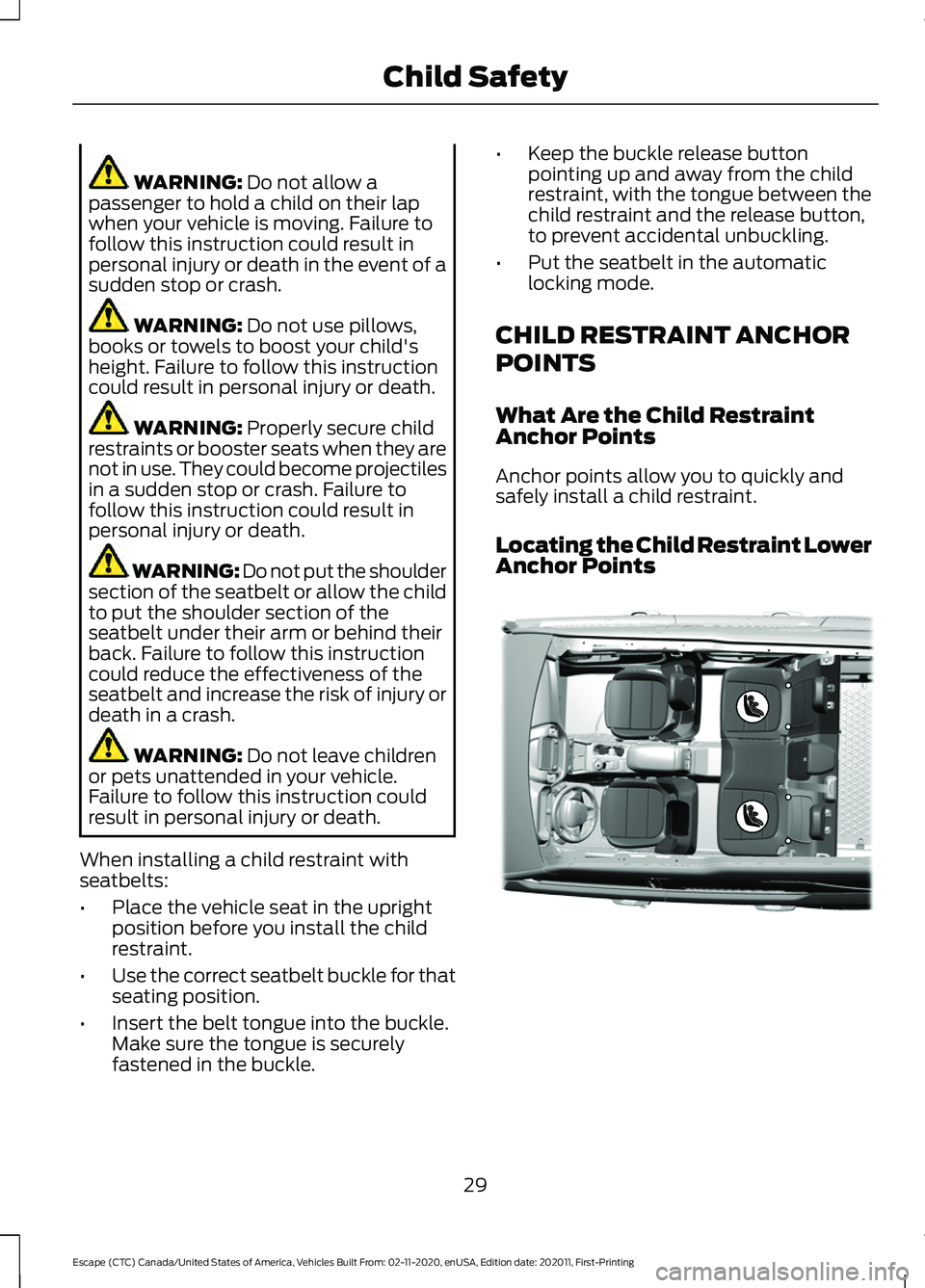
WARNING: Do not allow a
passenger to hold a child on their lap
when your vehicle is moving. Failure to
follow this instruction could result in
personal injury or death in the event of a
sudden stop or crash. WARNING:
Do not use pillows,
books or towels to boost your child's
height. Failure to follow this instruction
could result in personal injury or death. WARNING:
Properly secure child
restraints or booster seats when they are
not in use. They could become projectiles
in a sudden stop or crash. Failure to
follow this instruction could result in
personal injury or death. WARNING: Do not put the shoulder
section of the seatbelt or allow the child
to put the shoulder section of the
seatbelt under their arm or behind their
back. Failure to follow this instruction
could reduce the effectiveness of the
seatbelt and increase the risk of injury or
death in a crash. WARNING:
Do not leave children
or pets unattended in your vehicle.
Failure to follow this instruction could
result in personal injury or death.
When installing a child restraint with
seatbelts:
• Place the vehicle seat in the upright
position before you install the child
restraint.
• Use the correct seatbelt buckle for that
seating position.
• Insert the belt tongue into the buckle.
Make sure the tongue is securely
fastened in the buckle. •
Keep the buckle release button
pointing up and away from the child
restraint, with the tongue between the
child restraint and the release button,
to prevent accidental unbuckling.
• Put the seatbelt in the automatic
locking mode.
CHILD RESTRAINT ANCHOR
POINTS
What Are the Child Restraint
Anchor Points
Anchor points allow you to quickly and
safely install a child restraint.
Locating the Child Restraint Lower
Anchor Points 29
Escape (CTC) Canada/United States of America, Vehicles Built From: 02-11-2020, enUSA, Edition date: 202011, First-Printing Child SafetyE316405
Page 34 of 589
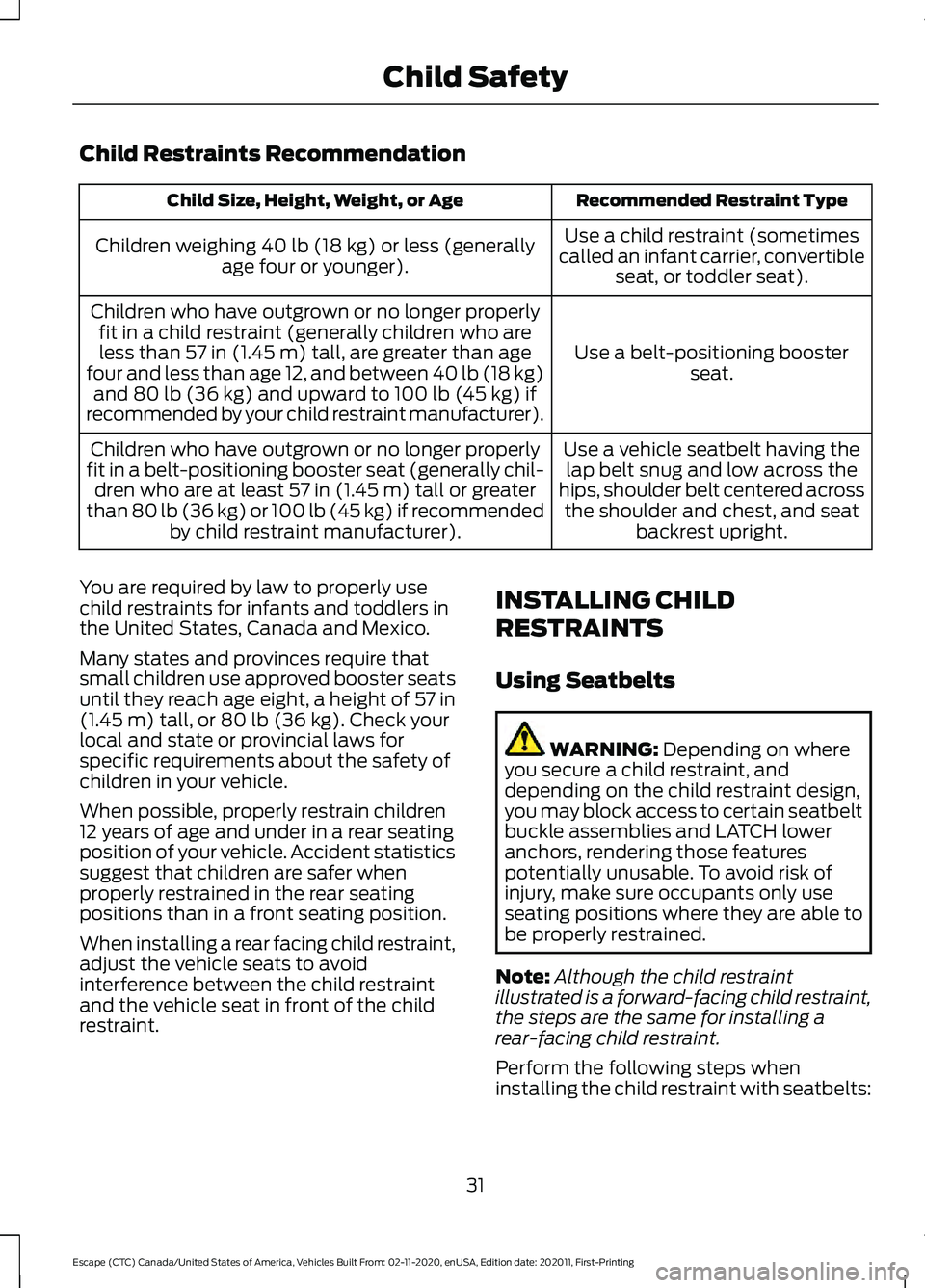
Child Restraints Recommendation
Recommended Restraint Type
Child Size, Height, Weight, or Age
Use a child restraint (sometimes
called an infant carrier, convertible seat, or toddler seat).
Children weighing 40 lb (18 kg) or less (generally
age four or younger).
Use a belt-positioning boosterseat.
Children who have outgrown or no longer properly
fit in a child restraint (generally children who areless than
57 in (1.45 m) tall, are greater than age
four and less than age 12, and between 40 lb (18 kg) and
80 lb (36 kg) and upward to 100 lb (45 kg) if
recommended by your child restraint manufacturer).
Use a vehicle seatbelt having thelap belt snug and low across the
hips, shoulder belt centered across the shoulder and chest, and seat backrest upright.
Children who have outgrown or no longer properly
fit in a belt-positioning booster seat (generally chil- dren who are at least
57 in (1.45 m) tall or greater
than 80 lb (36 kg) or 100 lb (45 kg) if recommended by child restraint manufacturer).
You are required by law to properly use
child restraints for infants and toddlers in
the United States, Canada and Mexico.
Many states and provinces require that
small children use approved booster seats
until they reach age eight, a height of 57 in
(1.45 m)
tall, or 80 lb (36 kg). Check your
local and state or provincial laws for
specific requirements about the safety of
children in your vehicle.
When possible, properly restrain children
12 years of age and under in a rear seating
position of your vehicle. Accident statistics
suggest that children are safer when
properly restrained in the rear seating
positions than in a front seating position.
When installing a rear facing child restraint,
adjust the vehicle seats to avoid
interference between the child restraint
and the vehicle seat in front of the child
restraint. INSTALLING CHILD
RESTRAINTS
Using Seatbelts WARNING:
Depending on where
you secure a child restraint, and
depending on the child restraint design,
you may block access to certain seatbelt
buckle assemblies and LATCH lower
anchors, rendering those features
potentially unusable. To avoid risk of
injury, make sure occupants only use
seating positions where they are able to
be properly restrained.
Note: Although the child restraint
illustrated is a forward-facing child restraint,
the steps are the same for installing a
rear-facing child restraint.
Perform the following steps when
installing the child restraint with seatbelts:
31
Escape (CTC) Canada/United States of America, Vehicles Built From: 02-11-2020, enUSA, Edition date: 202011, First-Printing Child Safety
Page 35 of 589
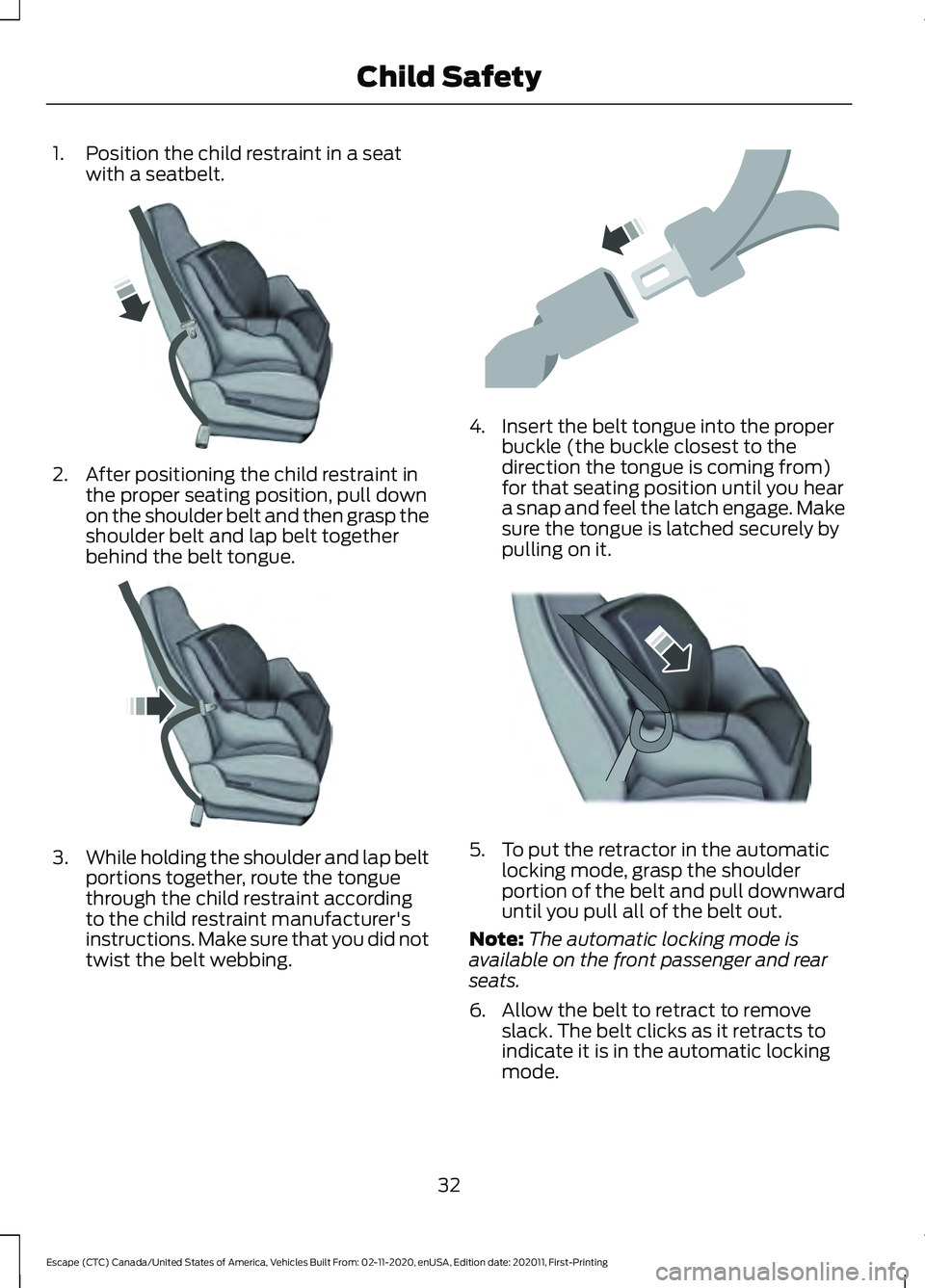
1. Position the child restraint in a seat
with a seatbelt. 2. After positioning the child restraint in
the proper seating position, pull down
on the shoulder belt and then grasp the
shoulder belt and lap belt together
behind the belt tongue. 3.
While holding the shoulder and lap belt
portions together, route the tongue
through the child restraint according
to the child restraint manufacturer's
instructions. Make sure that you did not
twist the belt webbing. 4. Insert the belt tongue into the proper
buckle (the buckle closest to the
direction the tongue is coming from)
for that seating position until you hear
a snap and feel the latch engage. Make
sure the tongue is latched securely by
pulling on it. 5. To put the retractor in the automatic
locking mode, grasp the shoulder
portion of the belt and pull downward
until you pull all of the belt out.
Note: The automatic locking mode is
available on the front passenger and rear
seats.
6. Allow the belt to retract to remove slack. The belt clicks as it retracts to
indicate it is in the automatic locking
mode.
32
Escape (CTC) Canada/United States of America, Vehicles Built From: 02-11-2020, enUSA, Edition date: 202011, First-Printing Child SafetyE142529 E142530 E142531 E142875
Page 39 of 589
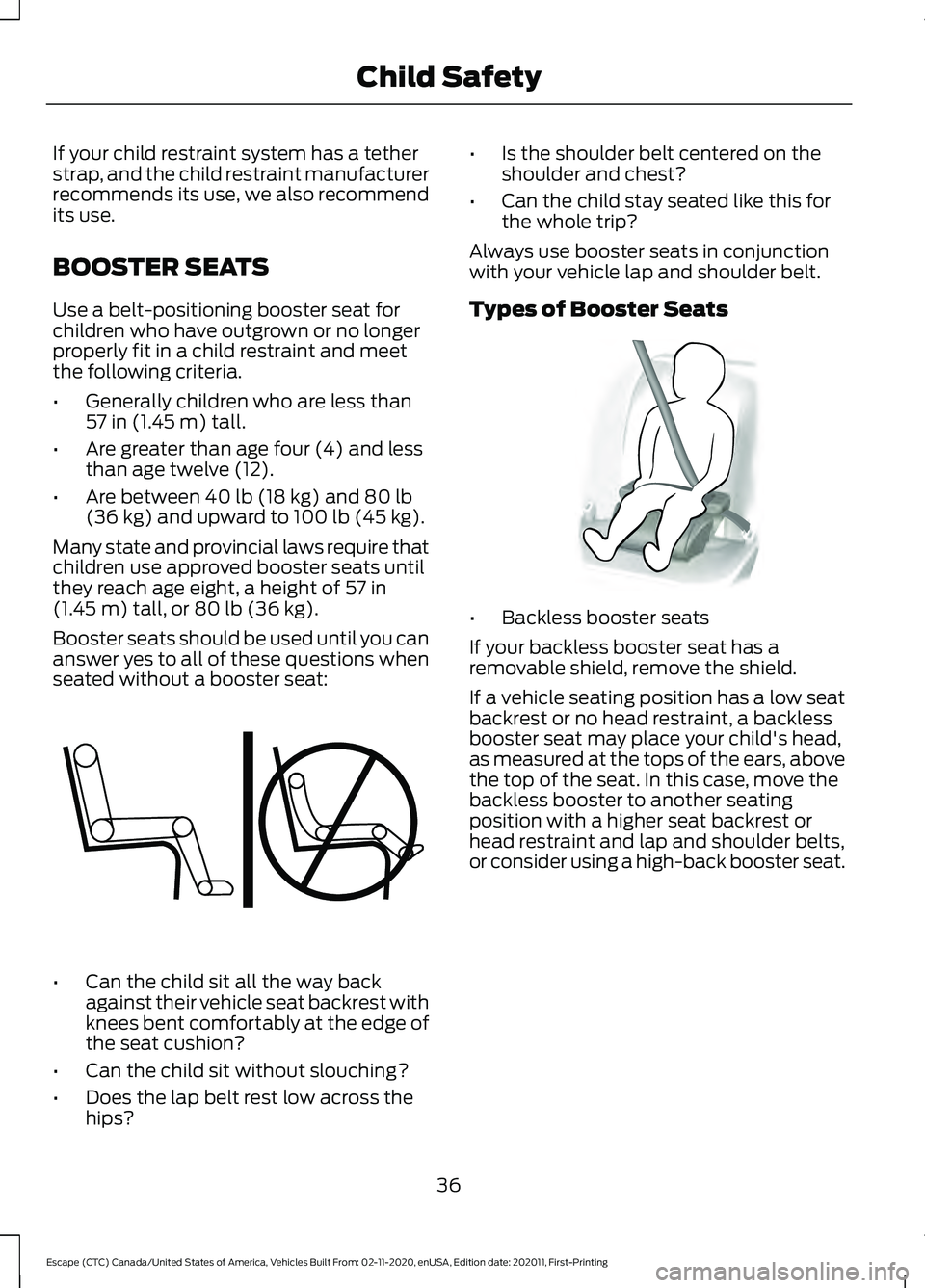
If your child restraint system has a tether
strap, and the child restraint manufacturer
recommends its use, we also recommend
its use.
BOOSTER SEATS
Use a belt-positioning booster seat for
children who have outgrown or no longer
properly fit in a child restraint and meet
the following criteria.
•
Generally children who are less than
57 in (1.45 m) tall.
• Are greater than age four (4) and less
than age twelve (12).
• Are between
40 lb (18 kg) and 80 lb
(36 kg) and upward to 100 lb (45 kg).
Many state and provincial laws require that
children use approved booster seats until
they reach age eight, a height of
57 in
(1.45 m) tall, or 80 lb (36 kg).
Booster seats should be used until you can
answer yes to all of these questions when
seated without a booster seat: •
Can the child sit all the way back
against their vehicle seat backrest with
knees bent comfortably at the edge of
the seat cushion?
• Can the child sit without slouching?
• Does the lap belt rest low across the
hips? •
Is the shoulder belt centered on the
shoulder and chest?
• Can the child stay seated like this for
the whole trip?
Always use booster seats in conjunction
with your vehicle lap and shoulder belt.
Types of Booster Seats •
Backless booster seats
If your backless booster seat has a
removable shield, remove the shield.
If a vehicle seating position has a low seat
backrest or no head restraint, a backless
booster seat may place your child's head,
as measured at the tops of the ears, above
the top of the seat. In this case, move the
backless booster to another seating
position with a higher seat backrest or
head restraint and lap and shoulder belts,
or consider using a high-back booster seat.
36
Escape (CTC) Canada/United States of America, Vehicles Built From: 02-11-2020, enUSA, Edition date: 202011, First-Printing Child SafetyE142595 E68924
Page 40 of 589
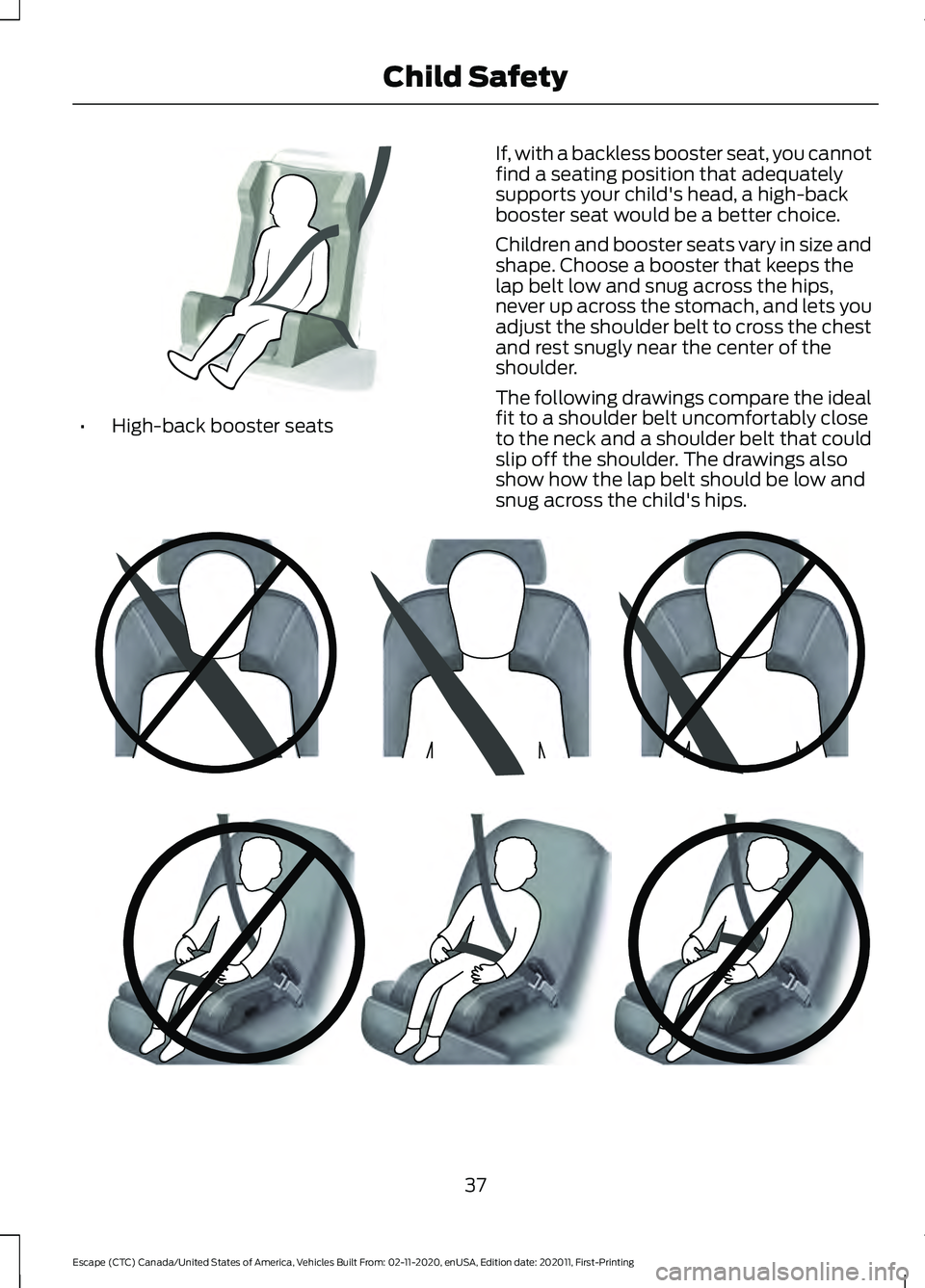
•
High-back booster seats If, with a backless booster seat, you cannot
find a seating position that adequately
supports your child's head, a high-back
booster seat would be a better choice.
Children and booster seats vary in size and
shape. Choose a booster that keeps the
lap belt low and snug across the hips,
never up across the stomach, and lets you
adjust the shoulder belt to cross the chest
and rest snugly near the center of the
shoulder.
The following drawings compare the ideal
fit to a shoulder belt uncomfortably close
to the neck and a shoulder belt that could
slip off the shoulder. The drawings also
show how the lap belt should be low and
snug across the child's hips.
37
Escape (CTC) Canada/United States of America, Vehicles Built From: 02-11-2020, enUSA, Edition date: 202011, First-Printing Child SafetyE70710 E142596 E142597
Page 42 of 589
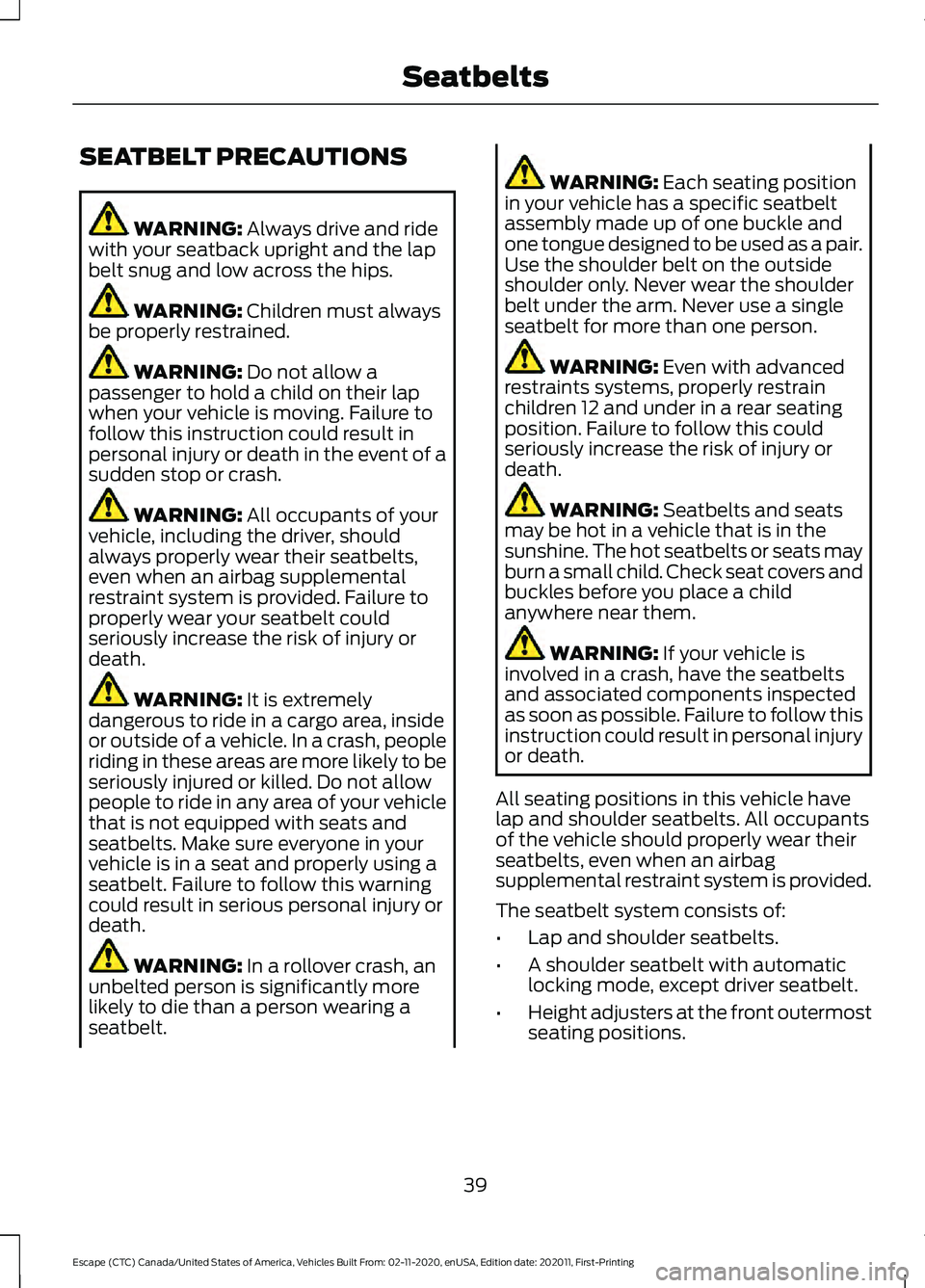
SEATBELT PRECAUTIONS
WARNING: Always drive and ride
with your seatback upright and the lap
belt snug and low across the hips. WARNING:
Children must always
be properly restrained. WARNING:
Do not allow a
passenger to hold a child on their lap
when your vehicle is moving. Failure to
follow this instruction could result in
personal injury or death in the event of a
sudden stop or crash. WARNING:
All occupants of your
vehicle, including the driver, should
always properly wear their seatbelts,
even when an airbag supplemental
restraint system is provided. Failure to
properly wear your seatbelt could
seriously increase the risk of injury or
death. WARNING:
It is extremely
dangerous to ride in a cargo area, inside
or outside of a vehicle. In a crash, people
riding in these areas are more likely to be
seriously injured or killed. Do not allow
people to ride in any area of your vehicle
that is not equipped with seats and
seatbelts. Make sure everyone in your
vehicle is in a seat and properly using a
seatbelt. Failure to follow this warning
could result in serious personal injury or
death. WARNING:
In a rollover crash, an
unbelted person is significantly more
likely to die than a person wearing a
seatbelt. WARNING:
Each seating position
in your vehicle has a specific seatbelt
assembly made up of one buckle and
one tongue designed to be used as a pair.
Use the shoulder belt on the outside
shoulder only. Never wear the shoulder
belt under the arm. Never use a single
seatbelt for more than one person. WARNING:
Even with advanced
restraints systems, properly restrain
children 12 and under in a rear seating
position. Failure to follow this could
seriously increase the risk of injury or
death. WARNING:
Seatbelts and seats
may be hot in a vehicle that is in the
sunshine. The hot seatbelts or seats may
burn a small child. Check seat covers and
buckles before you place a child
anywhere near them. WARNING:
If your vehicle is
involved in a crash, have the seatbelts
and associated components inspected
as soon as possible. Failure to follow this
instruction could result in personal injury
or death.
All seating positions in this vehicle have
lap and shoulder seatbelts. All occupants
of the vehicle should properly wear their
seatbelts, even when an airbag
supplemental restraint system is provided.
The seatbelt system consists of:
• Lap and shoulder seatbelts.
• A shoulder seatbelt with automatic
locking mode, except driver seatbelt.
• Height adjusters at the front outermost
seating positions.
39
Escape (CTC) Canada/United States of America, Vehicles Built From: 02-11-2020, enUSA, Edition date: 202011, First-Printing Seatbelts